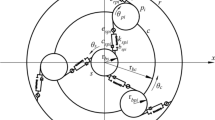Abstract
A nonlinear lateral-torsional coupled vibration model of a planetary gear system was established by taking transmission errors, time varying meshing stiffness and multiple gear backlashes into account. The bifurcation diagram of the system’s motion state with rotational speed of sun gear was conducted through four steps. As a bifurcation parameter, the effect of rotational speed on the bifurcation properties of the system was assessed. The study results reveal that periodic motion is the main motion state of planetary gear train in low speed region when n s <2 350 r/min, but chaos motion state is dominant in high speed region when n s >2 350 r/min, The way of periodic motion to chaos is doubling bifurcation. There are two kinds of unstable modes and nine unstable regions in the speed region when 1 000 r/minn s <3 000 r/min.
Similar content being viewed by others
References
HIDAKA T. Analysis of dynamic tooth load on planetary gear [J]. Bulletin of the Japanese Society of Mechanical Engineers, 1980, 23(176): 315–322.
PARKER R G, AGASHE V, VIJAYAKAR S M. Dynamic response of a planetary gear system using a finite element/contact mechanics model [J]. ASME, Journal of Mechanical Design, 2000, 122(9): 304–310.
LIN J, PARKER R G. Analytical characterization of the unique properties of planetary gear free vibration [J]. ASME, Journal of Vibration and Acoustics, 1999, 121(7): 316–321.
SAADA A, VELEX P. An extended model for the analysis of the dynamic behavior of planetary trains [J]. ASME, Journal of Mechanical Design, 1995, 117(6): 241–247.
KAHRAMAN A. Planetary gear train dynamics [J]. ASME, Journal of Mechanical Design, 1994, 116(3): 713–720.
AUGUST R, KASUBA R. Torsional vibration and dynamic loads in a basic planetary gear system [J]. Journal of vibration, Acoustics, Stress, and Reliability in Design, 1986, 108(7): 348–353.
LIN J, PARKER R G. Mesh stiffness variation instabilities in two-stage gear system [J]. Journal of Vibration and Acoustics, 2001, 124(6): 316–321.
AMBARISHA V K, PARKER R G. Nonlinear dynamics of planetary gears using analytical and finite element models [J]. Journal of Sound and Vibration, 2007, 302(1): 577–595.
KAHRAMAN A. Load sharing characteristics of planetary transmissions [J]. Mechanism and Machine Theory, 1994, 29(8): 1151–1165.
LIN J, PARKER R G. Planetary gear parametric instability caused by mesh stiffness variation [J]. Journal of Sound and Vibration, 2002, 249(1): 129–145.
SUN Tao, HU Hai-yan. Nonlinear dynamics of a planetary gear system with multiple clearances [J]. Mechanism and Machine Theory, 2003, 38(5): 1371–1390.
PARKER R G. A physical explanation for the effectiveness of planet phasing to suppress planetary gear vibration [J]. Journal of Sound and Vibration, 2000, 236(4): 561–573.
Author information
Authors and Affiliations
Corresponding author
Additional information
Foundation item: Project(50775108) supported by the National Natural Science Foundation of China
Rights and permissions
About this article
Cite this article
Li, Tj., Zhu, Rp., Bao, Hy. et al. Stability of motion state and bifurcation properties of planetary gear train. J. Cent. South Univ. Technol. 19, 1543–1547 (2012). https://doi.org/10.1007/s11771-012-1174-3
Received:
Accepted:
Published:
Issue Date:
DOI: https://doi.org/10.1007/s11771-012-1174-3




